Appeal to the Great Spirit, or "Chief Muncie"
Introduction
Text-to-speech Audio
Images
This is a postcard depicting "Appeal to the Great Spirit" and the surrounding area. It was made sometime after 1929, when the statue and surrounding park were opened to the public.
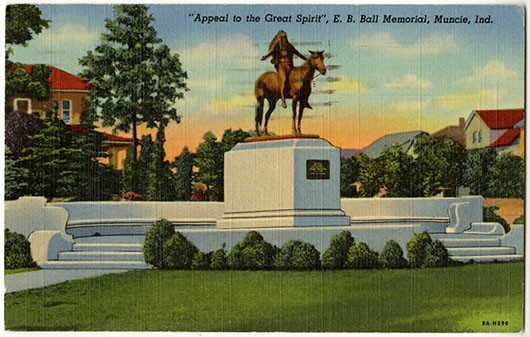
This is the city seal of Muncie, Indiana. "Appeal to the Great Spirit" has been on the Muncie city seal for decades.
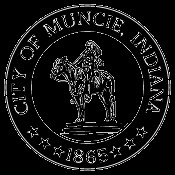
This is a photograph of the "Appeal to the Great Spirit" statue in Muncie, Indiana.
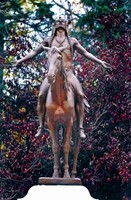
This photograph is part of a larger image that was featured on a postcard for Muncie, Indiana.
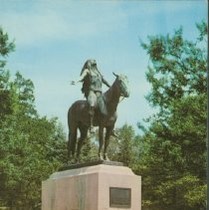
This is a map that shows some of the different routes that bands of Delaware traveled on during the removal process
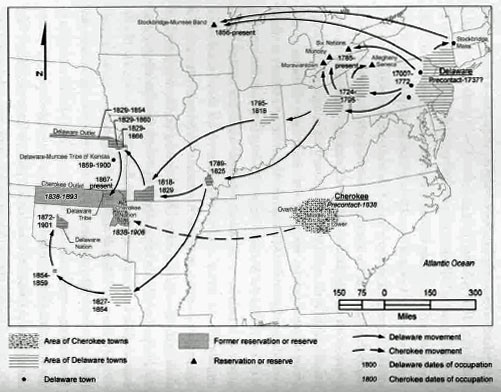
This is a photograph of the "Appeal to the Great Spirit" statue in Muncie, Indiana.
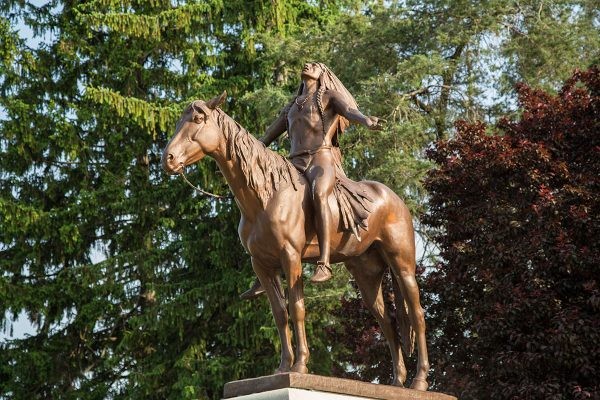
Backstory and Context
Text-to-speech Audio
History of "Appeal to the Great Spirit"
“Appeal to the Great Spirit” is a life-sized statue that is said to depict a Sioux warrior. The statue was created by artist Cyrus Dallin as part of a series of sculptures entitled, “The Epic of the Indian.” Dallin grew up in Utah where he encountered many Native Americans of the Ute tribe which may have inspired the later creation of these statues.1 The “Appeal to the Great Spirit” statue in Muncie is actually a replica of the “Appeal to the Great Spirit” statue at the Museum of Fine Arts in Boston, Massachusetts. The Ball family, owners of the Ball Brothers Glass Manufacturing Company, had commissioned Dallin for a copy of the “Appeal to the Great Spirit” statue so that it could serve as a memorial to the life of Edmund Burke Ball, who had died in 1925.2 However, “Appeal to the Great Spirit” did not become a large part of the city’s identity until the 1960s and 1970s, when citizens of Muncie began to see the statue as emblematic of their town.3 During this time, Muncie's city government integrated the imagery of the statue onto the city seal, mayoral letterhead, and municipal flag.Native American History of Muncie, Indiana
"Appeal to the Great Spirit" depicts a generalized Plains Native American. This design has, in fact, no historical accuracy as there were no Plains Native Americans in Indiana. In reality, the groups of Native Americans that inhabited the Muncie area were the Delaware or Lenape Native Americans and the Miami Native Americans. The Delaware were originally from the East coast of the United States, ranging from New York to Delaware.4 In the eighteenth century, they were removed from these areas and migrated to Indiana and Ohio. They settled in western Ohio and central/eastern Indiana until 1818 when the Treaty of St. Mary’s was signed, removing them from this region.4 It was during this time that the Lenape settled in the Muncie area. Two groups of Lenape people settled in the Muncie area, the Unami to the south and the Munsee to the north, along the White River. 4 There were also Miami Native American groups already in this area. There are no federally recognized tribes in Indiana, but there are numerous descendants of the Miami who still have ties to the land and the culture. All headquarters of Indigenous groups in Indiana were removed to Oklahoma, through the Treaty of St. Mary’s and subsequent treaties, where they remain today.
Settler Colonialism and the “Vanishing Indian”
“Appeal to the Great Spirit”, as the final installment in Dallin’s “Epic of the Indian”, was meant to represent the last prayers of a Sioux warrior who had realized that Native Americans were facing extinction.5 When people look at the “Appeal to the Great Spirit” statue, it is easy to think that Native Americans are a thing of the past – long extinct because of the actions of settler colonials. However, this is certainly not true. Dallin wanted people who viewed the statue to acknowledge the atrocities settler colonials had committed against Native Americans.1 However, this only continues the idea that Native Americans are a conquered people. Native Americans are here today, and throughout history they have played an active role in shaping our future as an American Nation. Instead of seeing “Appeal to the Great Spirit” as the representation of a people who are only present in the past, see it as a reminder that Native American history has always been intertwined with our own and as such, Native Americans cannot be ignored in the present.Lasting Impact
Appeal to the Great Spirit has become the “symbol” of Muncie, Indiana. Local legends say that the statue depicts a Native American leader named “Chief Muncie,” who the city was later named after. This myth has no historical backing, as there never was a “Chief Muncie” of any kind. This myth arose in the 1960s and 1970s and can still be heard today. Images of the statue appear in many different media associated with the city of Muncie, continuing the legend of “Chief Muncie”.7 The image of "Appeal to the Great Spirit" also appears as figurines and other works of art around the country. The statue’s image was put on the flag of Muncie in 1974, but was removed in the 1990s.6 The image was also put onto the seal of Muncie, where it remains today.7Sources
1Buss, James Joseph. “Appealing to the Great Spirit: Foundational Fictions and Settler Histories in Middletown America.” Middle West Review 2, no. 2 (2016): 146. DOI: 10.1353/mwr.2016.0002
2Buss, James Joseph. “Appealing to the Great Spirit: Foundational Fictions and Settler Histories in Middletown America.” Middle West Review 2, no. 2 (2016): 143. DOI: 10.1353/mwr.2016.00023Buss, James Joseph. “Appealing to the Great Spirit: Foundational Fictions and Settler Histories in Middletown America.” Middle West Review 2, no. 2 (2016): 144. DOI: 10.1353/mwr.2016.0002
4Removal History of the Delaware Tribe. Official Site of the Delaware Tribe of Indians. Accessed April 21, 2017. http://delawaretribe.org/services-and-programs/historic-preservation/removal-history-of-the-delaware...
5Buss, James Joseph. “Appealing to the Great Spirit: Foundational Fictions and Settler Histories in Middletown America.” Middle West Review 2, no. 2 (2016): 147. DOI: 10.1353/mwr.2016.0002
6Buss, James Joseph. “Appealing to the Great Spirit: Foundational Fictions and Settler Histories in Middletown America.” Middle West Review 2, no. 2 (2016): 156. DOI: 10.1353/mwr.2016.0002
7Buss, James Joseph. “Appealing to the Great Spirit: Foundational Fictions and Settler Histories in Middletown America.” Middle West Review 2, no. 2 (2016): 160. DOI: 10.1353/mwr.2016.0002
Photo Credits (in order of appearance):
"Appeal to the Great Spirit" Postcard: http://www.minnetrista.net/blog/2013/08/22/ball-family-history/there-wasn-t-a-chief-munsee.-really-t...
Muncie city seal: http://www.cityofmuncie.com/
"Appeal to the Great Spirit" Photograph: http://www.visitmuncie.org/appeal-to-the-great-spirit/
"Appeal to the Great Spirit" Postcard (Photograph): http://minnetrista.pastperfectonline.com/bysearchterm?keyword=Appeal+to+the+Great+Spirit
Map of Delaware Tribe Removal: http://delawaretribe.org/services-and-programs/historic-preservation/removal-history-of-the-delaware...
"Appeal to the Great Spirit" Photograph: https://visitindiana.com/blog/index.php/2017/01/27/muncie-public-artworks/
If this is a topic that interests you, here are a few books you might enjoy:
Facing East From Indian Country, by Daniel Richter.
Imprints: The Pokagon Band of Potawatomi Indians and the City of Chicago, by
John N. Low.
Native Americans of East-Central Indiana, by Chris Flook.
